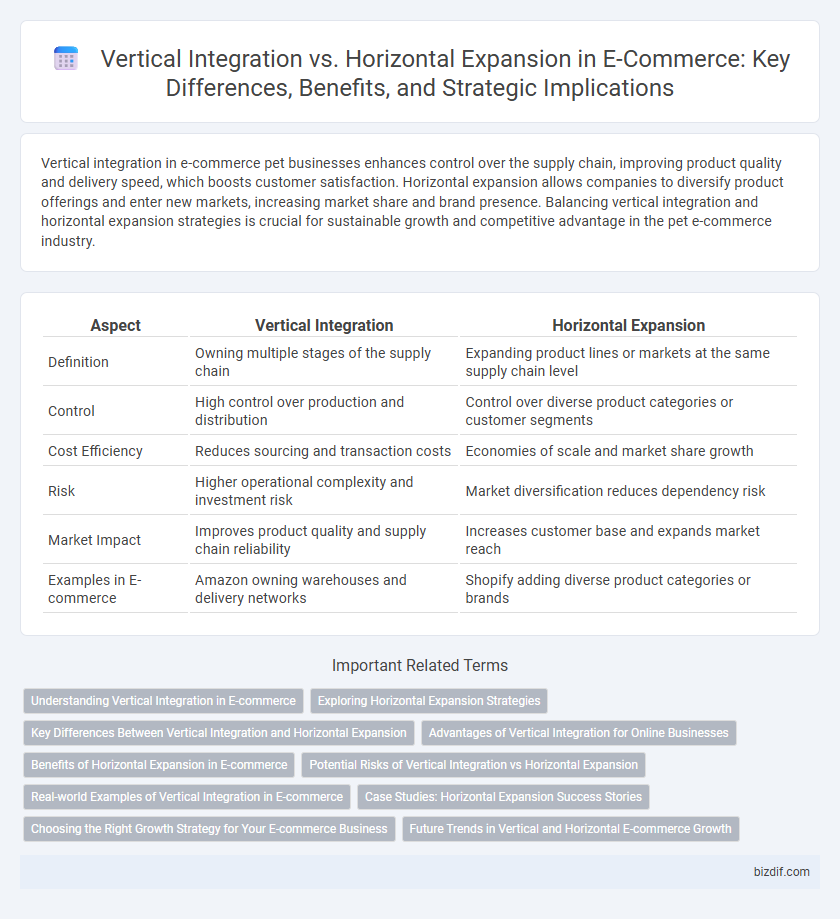Vertical integration in e-commerce pet businesses enhances control over the supply chain, improving product quality and delivery speed, which boosts customer satisfaction. Horizontal expansion allows companies to diversify product offerings and enter new markets, increasing market share and brand presence. Balancing vertical integration and horizontal expansion strategies is crucial for sustainable growth and competitive advantage in the pet e-commerce industry.
Table of Comparison
| Aspect | Vertical Integration | Horizontal Expansion |
|---|---|---|
| Definition | Owning multiple stages of the supply chain | Expanding product lines or markets at the same supply chain level |
| Control | High control over production and distribution | Control over diverse product categories or customer segments |
| Cost Efficiency | Reduces sourcing and transaction costs | Economies of scale and market share growth |
| Risk | Higher operational complexity and investment risk | Market diversification reduces dependency risk |
| Market Impact | Improves product quality and supply chain reliability | Increases customer base and expands market reach |
| Examples in E-commerce | Amazon owning warehouses and delivery networks | Shopify adding diverse product categories or brands |
Understanding Vertical Integration in E-commerce
Vertical integration in e-commerce involves controlling multiple stages of the supply chain, from product manufacturing to distribution and retail, enhancing operational efficiency and reducing dependency on third-party suppliers. This strategy enables e-commerce companies to ensure consistent product quality, streamline inventory management, and improve customer experience through faster delivery and better service. By consolidating supply chain components, businesses can decrease costs, increase profit margins, and gain greater market control.
Exploring Horizontal Expansion Strategies
Horizontal expansion strategies in e-commerce involve acquiring or merging with competitors or entering adjacent market segments to increase market share and diversify product offerings. Leveraging data analytics and customer insights enhances targeted marketing and inventory optimization across newly integrated platforms. Strategic partnerships and cross-channel integrations boost customer engagement and streamline supply chain efficiency, driving scalable growth.
Key Differences Between Vertical Integration and Horizontal Expansion
Vertical integration in e-commerce involves acquiring or controlling multiple stages of the supply chain, such as manufacturing, warehousing, and retail, enabling greater control over product quality and cost efficiency. Horizontal expansion focuses on increasing market share by acquiring or merging with competitors or businesses offering similar products, enhancing customer base and distribution channels. Key differences lie in vertical integration's aim to streamline operations internally while horizontal expansion targets growth through external market presence and diversification.
Advantages of Vertical Integration for Online Businesses
Vertical integration empowers online businesses to control supply chains, reduce costs, and improve product quality by managing production and distribution internally. It enhances customer experience through faster delivery and consistent service standards, fostering brand loyalty. Owning multiple stages of the value chain also enables better data integration and strategic decision-making, driving long-term growth in e-commerce markets.
Benefits of Horizontal Expansion in E-commerce
Horizontal expansion in e-commerce enables businesses to diversify product offerings and reach new customer segments, increasing market share and revenue streams. It enhances competitive advantage by leveraging existing infrastructure and brand recognition to enter related markets with lower risk than vertical integration. Expanding horizontally also fosters economies of scale in marketing, logistics, and customer service, improving operational efficiency and profitability.
Potential Risks of Vertical Integration vs Horizontal Expansion
Vertical integration in e-commerce can lead to increased operational complexity and substantial capital investment risks, potentially causing supply chain inflexibilities and reduced adaptability to market changes. Horizontal expansion risks include market saturation, dilution of brand identity, and intensified competition within new product categories or geographic regions. Both strategies require careful risk management to avoid financial strain and preserve customer loyalty.
Real-world Examples of Vertical Integration in E-commerce
Amazon exemplifies vertical integration in e-commerce by controlling its supply chain through owning warehouses, delivery services, and developing proprietary products like the Amazon Echo. Alibaba integrates vertically by managing logistics via Cainiao Network and hosting payment platforms such as Alipay to streamline transactions. Shopify extends control over its ecosystem by providing merchants with tools for online storefronts, payment processing, and shipping solutions.
Case Studies: Horizontal Expansion Success Stories
Many e-commerce giants like Amazon and Walmart have demonstrated the effectiveness of horizontal expansion by diversifying their product offerings and entering new market segments while maintaining their core competencies. Case studies reveal that horizontal growth enables these companies to leverage existing customer bases, optimize supply chains, and enhance economies of scale, driving revenue and market share increases. This strategy often results in competitive advantages through cross-selling opportunities and broader brand recognition across various categories.
Choosing the Right Growth Strategy for Your E-commerce Business
Vertical integration in e-commerce involves controlling multiple stages of the supply chain, from manufacturing to distribution, enhancing profit margins and quality control. Horizontal expansion focuses on broadening product lines or entering new markets to increase customer base and market share. Selecting the right growth strategy depends on factors such as your current operational capabilities, market demand, competitive landscape, and long-term business goals.
Future Trends in Vertical and Horizontal E-commerce Growth
Vertical integration in e-commerce enables companies to control supply chains and enhance customer experience through streamlined operations and exclusive product offerings. Horizontal expansion focuses on diversifying product categories and entering new markets to increase market share and customer base. Future trends indicate a blend of both strategies, with businesses leveraging technology like AI and blockchain to optimize supply chain management while simultaneously expanding product lines for broader market reach.
Vertical Integration vs Horizontal Expansion Infographic

 bizdif.com
bizdif.com